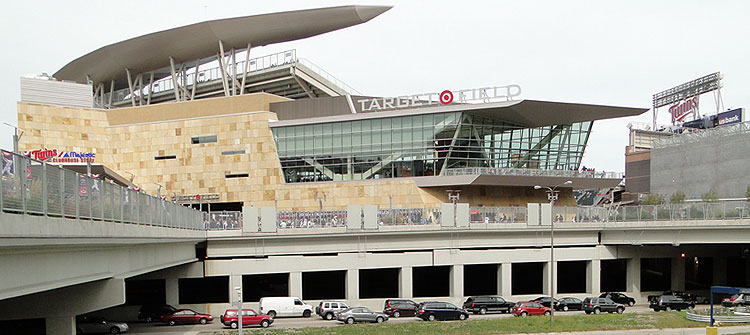
|
Built on the cusp of downtown Minneapolis and nestled into just an 8-acre plot of land, the Minnesota Twins' Target Field is a small ballpark in a small market that is big time impressive.
Made with a lot of native limestone a short distance from the Metrodome, the Twins' new home is next to the Target Center, where the NBA's Timberwolves play, and the arena and the Minneapolis skyline behind it provide a great backdrop for the angular ballpark, which features steeply sloped outfield seating and a roof that's as interesting in design as it's functional, thanks to designers cleverly choosing to embed light banks in the silver metal “canopy” that gives Target Field such a distinctive look. The lack of light towers contributes to the intimacy of the majors' third smallest ballpark (behind Fenway and PNC parks). The intimacy of Minnesota's 39,504-seat bandbox was necessitated by the structures that previously stood around it, as Target Field is boxed in place by two elevated highways, an interstate (I-394), and, of all things, a trash incinerator. So the ballpark's angles, dimensions and overall design are not gimmicky or contrived, but the end result of the architects' ingenuity in placing it in a parcel that was only two-thirds the acreage of what was deemed appropriate. If they had the 12 acres desired then the sizeable parking garage in right-center field wouldn't quite literally abut the ballpark. Because it does the mezzanine outfield seating there must rise vertical quickly. Those not sitting there don't necessarily notice the steep slope, but they will notice the unique shape of the four seating sections of varying height that mostly obscure what's officially called the 5th Street North Tad Garage. The rest of the 1,600-space parking structure is mostly hidden by wind screening.
High above the fence and stands in left-center field is the mega scoreboard. At 101 feet wide by 57 feet high it was the major's fourth largest scoreboard when it debuted, and as expected in this day and age everything it displays is in high-definition. Additional scoreboards provide information on the right-center field wall (out of town scores) and on the back wall and the facade above the field-level bullpens in left-center, upon which pitching statistics are naturally displayed. Natural elements are a big part of the Twins’ ballpark experience, specifically the sun, wind, rain and even the snow, all of which were blocked from having an effect on the ballgame in the Metrodome, the Teflon-coated fiberglass and air-supported dome that was fittingly derided as one of baseball's worst ever venues. Still, the Twins had much success in their home of 28 years and twice won a Game 7 of a World Series there. Those two championship years and each of the Twins’ other playoff seasons are remembered on flags that flap in the Minneapolis breeze from atop the portion of the left field grandstand that is known as the Home Run Porch. Rising a little beyond the height of the two-tier Home Run Porch is a party deck that is found in the left field corner. Capable of holding 250 people, the rooftop deck (team offices are below) boasts of a fire pit that will keeps its occupants warm whenever there's a chill in the air. Of those up there only 120 get fixed seats and that’s on bar stools behind drink rails. Seating in the rest of the ballpark runs the gamut from plush chairs for the big spenders in the lower level behind home plate to the not so comfy bleachers with backs that comprise all of the first level of seating in left field and in the right field corner. The bulk of the ballpark’s seats (82%) are the modern day standard issue chairbacks, dark green in color and with cup holders attached. All are angled, if need be, towards what fans want to see. Those sitting in club level do so on wood-backed plastic chairs with a cushioned bottom. Seats of the same elegant-looking finish are found in right field beneath the distinctive wedge-shaped sections with the steep slope. When it comes to elegance, Target Field has it in spades thanks to the golden-hued limestone that dominants the exterior and enhances the interior in various places, including the tops of the dugouts.
Nice touches don’t end with flowers and limestone. Nowhere is that more evident than the Target Plaza. Set outside of Target Field’s main entrance in right field, it contains everything a hometown baseball fan could hope for -- metal pennants dedicated to all past Twins teams and team-inducted Hall of Famers, bronze statues of the team’s three Cooperstown-enshrined players, a glass Minnesota ballpark history memorial and the “Golden Glove,” an oversized fielder’s mitt that serves as a tribute to every Twin to ever win the Gold Glove award. The name of each who did is listed on a placard near the glove, which is a favorite photo-op spot for fans since it is big enough to hold three comfortably at a (picture) time. The gate in right field is numbered 34 in honor of Kirby Puckett, one of five Twins players to have their number retired by the team. Harmon Killebrew, Tony Oliva, Kent Hrbek and Rod Carew are the others and their retired uniform numbers -- 3, 6, 14, 29 -- are the numbers of the ballpark’s remaining four gates. While plenty of praise is heaped upon Minnesota’s baseball legends, the rank and file roster players are given their due on the third base-side walkway, where the outer wall outside of Target Field is lined with historical Twins baseball cards from the likes of Leo Cardenas, Greg Gagne and Frank Quilici in addition to other mostly common cards, each a replica of a Topps original. While different generations of Upper Midwest fans will better enjoy different parts of their timeline-based stroll down the “Wall of Cards” memory lane it’s the greats that appeal to the masses and two of them are celebrated with their very own themed concessions instead of Target Field. Minneapolis-born Kent Hrbek is honored with a good time joint just inside of his home plate-based tribute gate and the grill and (mostly) bar that’s there is often overflowing because of its prime location. Simply named Hrbek’s, the bar’s walls are lined with mementos of Hrbek’s 14-year playing career and all of its bartenders wear replicas of his #14 jersey. Tony Oliva wasn’t born in Minnesota but the Cuban native spent his whole playing career there, becoming a fan favorite during a lengthy career that produced 1,917 hits. Thanks to numerous portable Tony O's Cuban sandwich carts on the concourse, Olivia has become Minnesota’s version of Boog Powell, Greg Luzinski and Manny Sanguillen, each of whom were long tenured players for the teams that they have remained strongly associated with due to their celebrity food vendor status in ballparks that opened long after their playing days ended. For the record, a Tony O’s Cuban sandwich consists of ham, pulled pork, Swiss cheese, Dijon mustard and pickles. As is custom at any modern ballpark, culinary options are plentiful. Perhaps nothing is more Minnesotan than a walleye on a stick, which is the official state fish fried and skewered. Food and beverage point of sales aren’t limited to being inside the ballpark, as Target Plaza has them too. Near the plaza but within the ballpark’s confines is the ritzy Metropolitan Club, a 400-seat club level restaurant for season ticket holders. Also on club level is the Town Ball Tavern. Open to all fans, the tavern’s most notable item of décor is its wood floor, which was the same one used by the Minneapolis Lakers in their final season in the Land of 10,000 Lakes before moving to Los Angeles. An homage to an old basketball arena aside, the club level’s concourse is more notable for its display of framed pictures of current major league ballparks. Framed pictures are actually a common site throughout Target Field as over 1,000 of them are hung from its many walls. Money was also invested in artwork, such as the large laser-burned images of Rod Carew and Kirby Puckett that are on wood and featured in the club level atriums named for each player. Viewable to the masses are the native Minnesota murals collectively known as the 5th Street Panels. Created by local artist Craig David, they can be seen at street level outside of the ballpark along its left field façade between gates 3 and 6. There are three murals, each 8’ tall and made of porcelain ceramic, and they depict scenes of local importance that are detailed in plaques at their base. Those not needing surroundings soaked in sophistication or much in the way of creature comforts should head to the upper level, where a pair of two sections wide Twins Pubs overlook the field directly behind home plate. Mainly there for those that like to stand and drink, the ballpark’s organist is sure to be in the one just to the first base side, as it’s where her organ is. The pubs are placed between the split-level upper deck, which is split into terrace (lower) and view (upper) levels. The big grandstand in left field is similarly split into two unequal halves, with more seats above the gap than below. The gaps ensure that the upper concourses are open to the playing field just like they are on the main (street-level) concourse. Drink rails that are placed on the concourses encourage standing and interacting with other fans. More often than not fans can stand where they like, so long as they stay behind the blue lines that denote certain areas of the concourse as off limits. Despite being mostly covered, the main level concourse is airy in addition to being well lit. The upper deck’s concourse has skywalks and staircases to service its sections, all of which offer sweeping views of a ballpark that is a beauty to behold. The press takes all the sights in from their club level box, which is open-air unless the weather dictates that its glass panels be fitted into place. Glass is not an uncommon sight at Target Field. The 4,600-square foot main team store in the right field corner is mainly enclosed with it. Glass paneling adorns the field facing portions of the Twins’ administrate offices in the left field corner and the Metropolitan Club restaurant catches the eye for the same reason the close to it main Twins store does: glass frames its angular design. Although limestone dominates the ballpark’s exterior some glass is present. But the wood that is featured is what really stands out as the primary contrast to Target Field’s golden façade. On each side of the ballpark are horizontal spans of shutter-like wooden panels that project the ruffled fan-like look of an accordion. The wood, imported from Brazil and called ipe, is dark brown in color and is a true hardwood. Its durability is such that it was used to reconstruct Atlantic City’s famous and previously pine boardwalk. Given baseball’s dependency on wood and the sport’s enduring appeal, the long-lasting Brazilian hardwood is a perfect accent to Minnesota’s ballpark. While the ipe had a long way to travel to get to Minneapolis, the pole that flies the American flag in the ballpark underwent a nearly 30-year journey to end up in the portion of the Target Plaza that is inside of Target Field. Erected just behind the cantilevered overlook sections in right field, the flag pole is a relic from the days of Metropolitan Stadium, the Twins' original Minnesota home in the southern suburb of Bloomington. When "the Met" closed in 1981 its 90' tall flag pole was sold to the manager of Richfield American Legion Post 435 for $1,500. The Twins got it back in 2009 by pledging $10,000 to the post's baseball team, then cut the pole in half. So Old Glory now flaps from 45 feet on the pole that was probably much more anonymous during its days at the old stadium, which was a dozen miles away until it was bulldozed in 1985. A more traditional ode to the Twins’ past can be seen in left field, where all numbers retired by the team are affixed to the façade of the club level concourse that is beneath the Twins’ administrate building. Each circular marker is outlined in red and the numbers they contain are also red in color. Jackie Robinson’s league-wide retired #42 is an exception as it’s in Dodger blue. As the men who wore the no longer wearable numbers would likely attest, it’s never easy to achieve excellence in any field, but when it comes to a field of play those who dreamed up, built and otherwise breathed life into Target Field produced something that is indeed excellent. From its location to its amenities, sightlines and design, Target Field hits the proverbial grand slam. Simply put, the limestone encased home of the Minnesota Twins can be summed up in one word: impressive.
Location and ParkingTarget Field is in the Warehouse District section of Minneapolis, a mere one mile from the ballpark’s namesake’s corporate headquarters. While the Twins didn’t arrive in the Twin Cities until 1961 and the first Target store didn’t open its doors in nearby Roseville until a year later, the Warehouse District dates to the latter half of the 19th century and the oldest of the many original brick structures still standing in it, the Pacific Block building, opened in 1865. That year is listed as the beginning one for the district's "period of significance," which spanned until 1930. Many years of decline would settle in the district before the Twins and their limestoned stadium finally did. Prior to the arrival of big league baseball, the nominating papers that chose the district's 65-year period of significance succeeded in getting it added to the National Register of Historic Places, which happened in 1989. A year later Target Field's neighbor, the Target Center, opened. The nearly 20,000-seat arena is best known for being the home of the NBA’s Minnesota Timberwolves. The arena is east of the ballpark. Hemming it in on the west is the Hennepin Energy Recovery Center, a garbage incinerator usually referred to by its acronym. The HERC is where all trash collected in the city goes to get converted into electricity that is then sold to Xcel Energy, which makes the green initiative an innovative revenue producing one. Directly north and south of Target Field are two elevated highways, the 5th Street Bridge (north) and 7th Street Bridge (south), each so named because of their second-story elevation. The ballpark’s main concourse and its entrance gates are at “bridge” level. Recessed beneath the Target Plaza is I-394. Running beneath Target Field’s third base grandstand is a tunnel for the Cedar Lake Trail, a three-lane bike and pedestrian path. Behind the left field stands is a two-level train station, known as the Target Field station. Light rail service uses the upper level, which is even with Target Field’s main concourse, while passengers on the Northstar commuter rail depart and are dropped off below. The platform for the light rail is quite close to the ballpark’s Gate 6. The light rail train, called the Hiawatha Line, is especially useful, as it connects Target Field to the Minneapolis-St. Paul International Airport and the Mall of America that’s not too far beyond the airport. The mall, which is the United States’ largest, is in Bloomington and was built on the site of the Twins’ original stadium. In its amusement park (yes, it’s that big) is a marker designating where home plate at Metropolitan Stadium was. Six blocks north of the Twins’ current ballpark is the Mississippi River. Downtown Minneapolis is almost at Target Field’s doorstep as the city’s skyscrapers begin to rise on the other side of the Target Center. The Minnesota State Capitol building is a dozen miles further east in St. Paul, which is close enough that it and Minneapolis have long been referred to as the Twin Cities, hence the baseball team’s name. For those not arriving via rail, there is plenty of parking adjacent to and near Target Field. Three big parking decks that can collectively hold about 7,000 vehicles make up the adjacent portion. Another estimated 20,000 spaces are within a mile of the ballpark. And since Minnesotans love to bicycle there are plenty of bike racks on ballpark property.
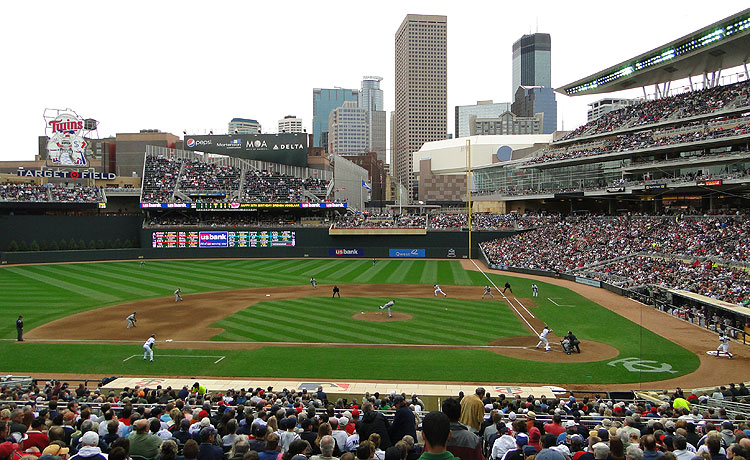
Target Field Facts, Figures & Footnotes
Target Field FirstsOfficial ballpark firsts (all of which occurred on 4/12/10):
| ||||||||||||||||||||||||||||||||||||||||||||||||||||||
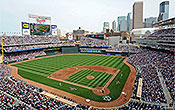

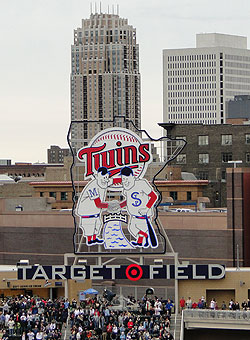 The highlight of Target Field is what's not hidden from the view of most fans, and most notably that's the Minneapolis skyline that looms large beyond right field and the giant old-school logo in center field, which is 46 feet tall and is the flashiest piece of non-pyrotechnical home run celebration flair in the majors, as the cartoonish Minnie and Paul shake hands -- or at least they appear to thanks to the illuminating pattern of neon lighting -- whenever a Twins hitter hits one over the fences.
The highlight of Target Field is what's not hidden from the view of most fans, and most notably that's the Minneapolis skyline that looms large beyond right field and the giant old-school logo in center field, which is 46 feet tall and is the flashiest piece of non-pyrotechnical home run celebration flair in the majors, as the cartoonish Minnie and Paul shake hands -- or at least they appear to thanks to the illuminating pattern of neon lighting -- whenever a Twins hitter hits one over the fences.
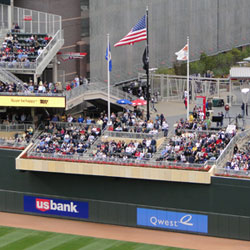 Limestone - and lots of it - was used to build Target Field, including on the facing of the Overlook sections in right field
Limestone - and lots of it - was used to build Target Field, including on the facing of the Overlook sections in right field
